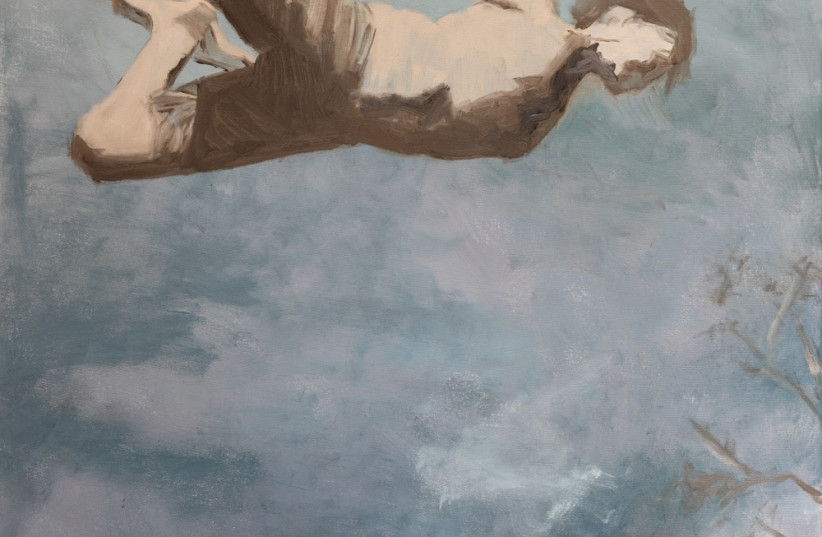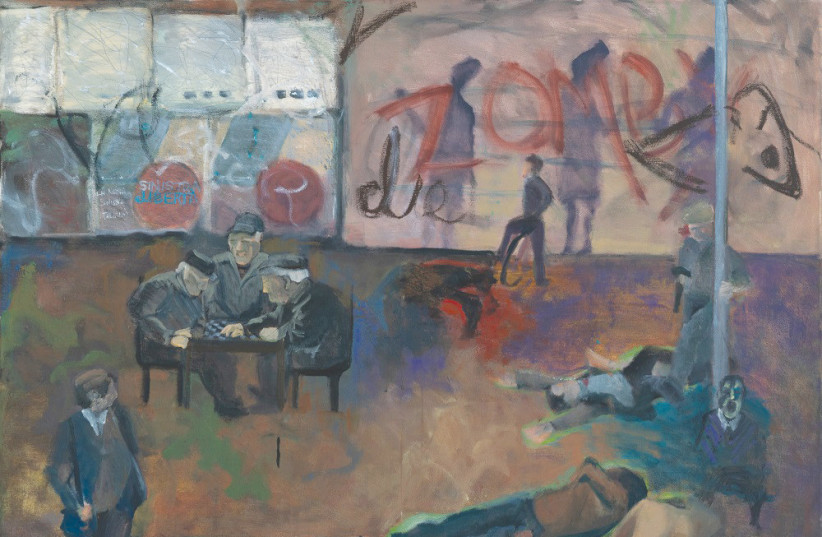Fire and snow from painter Linda Adams, who unveils her first solo show in Tel Aviv

Canadian-born Jerusalemite painter unveils her first solo show.
There is a lot to be said for tension. Yes, it can set the pulse racing far beyond its natural healthy level, but it can also act as a catalyst for generating some new departure, shunting us out of our comfort zone and fueling some uncharted creative avenue.
Linda Adams embraces that line of thinking, and conveys a checks and balances viewpoint in the works that are currently on show, in her Fire and Snow exhibition curated by Ron Bartos, at Artists’ House in Tel Aviv. It is the 62- year-old Canadian-born Jerusalemite’s first solo outing following a string of slots in group exhibitions over the years.
When we meet, a few days before the grand opening, I espy a motley spread of completed and gestating canvases dotted around her studio in the sleepy Greek Colony of Jerusalem. Generous quantities of requisite natural light pour in through the large arched window by the kitchen area as we settle down to talk about where Adams is currently at, and how she got there.
Seems serendipity, and generosity of spirit, helped to set Adams on her way to artistic expression. “It started off, actually, supporting a friend who wanted to go back to painting. I said, we’ll take a class. You’ll paint, I’ll look out of the window and we’ll go for a coffee,” she recalls. “And then I just sort of fell in love with painting.” The love affair smoldered for a while, back in Montreal, as Adams took art classes “here and there.”
She began to take things a little more seriously after making aliyah, with her husband and four children, 15 years ago. That was after an earlier stint here on a kibbutz near the Lebanese border in the 1980s, which was followed by a degree in agriculture. Adams took a long and winding route to her current pursuit, even qualifying and practicing as a lawyer for a while in Canada.
She says it was clear to her, from the outset, that legal beagling was not going to be her primary post-aliyah daytime interest. “I don’t have any friends here from the kindergarten, and I wasn’t in the army,” she notes, referencing the Israeli proteksia (connections) professional advancement and social system. “I would probably end up representing a bunch of American businessmen. I didn’t want to do any of that.”
After dutifully toeing the line, and gaining the expected professional credentials, in “kosher” lines of work, it was time Adams did her own thing. “I decided to follow my heart, and see where that led,” she says. “I thought I had a little journey I needed to go on.”
That B-road odyssey started to gather pace as Adams began to find her way into the local art world, honing her skills at various educational and other professional outlets, principally the Studio of Her Own Women’s Arts Center and the Jerusalem Studio School (JSS) where she enrolled in the Master Class Program given by leading figurative artist Israel Hershberg.
Adams’s kibbutz work experiences, and her background in agriculture, resonated powerfully with the JSS ethos. “I loved that they talked a lot about engaging with the material, the physicality of the work, and also the way they taught the fundamentals of painting. That really appealed to me. I learned about the classics and about the masters, and color and composition, and drawing. There was a lot of emphasis on drawing.”
Her encounter with Studio of Her Own helped Adams moved on down the road, not only to artistic self-expression but also to hanging out her shingle and pushing her boat out there, to the public. “Studio of Her Own was just a blessing. I love [founder-director] Zipi Mizrachi, she has dedicated all her efforts to that place. No one had been inside my studio before I went there. This was just a solo activity until about a year and a half ago,” she says.
Pandemic lockdown-constrained activity also came into play. “Ginot Ha’ir had this thing during corona, like lehipagesh bechatzer (meeting in the yard). People would open up their porches and yards.” A leap of faith was in the offing. “So I opened up the studio. I was terrified. I didn’t know how you let people in [to her inner artistic world]. I set up this corkboard thing, with about 30 paintings up there.”
It was a sobering but ultimately invaluable learning experience. “The strangest thing happened. People wandered around and were drawn to completely different things. They would look at a particular painting and say, this one, this feels very authentic to me. In my language, there is no greater compliment than authenticity,” she laughs. “I realized it was okay that people liked some things and didn’t like other things. I thought I guess it is really true. People are drawn to different things.”
Now – armed with that precious realization – Adams is letting the public in on some of the work she has been producing over the past decade and a half. The selected 20 canvases display her embrace of figurative and landscape scenes, as well as abstraction, and yin-yang oscillations between projects fueled by her grasp of the contrasting elements in the exhibition title.
In her artist statement, Adams expounds on the way she relates to interfaces between diametrically contrasting areas, and how that seeming insoluble clash drives her to explore new ground. “When I look at the world, I see surfaces and the meeting points between them. I paint to enter that interior and find meaning in what reflects back to me, to bridge the gap between what I see and my inner experience. To me, that is as true of nature as it is of still life or even my own reflection in the mirror – all of which surprise equally.”
Visitors to Artists’ House may very well be surprised by the thematic span of the exhibits which, fittingly, include an oil work called Leap of Faith. Another painting, a dystopian-leaning scene called Urban Decline, catches my eye. “This is a bunch of references collaged together,” she observes. Some of those are of a political nature as Adams seeks to reconcile what she perceives to be nefarious left-wing shenanigans with her upbringing in the Hashomer Hatzair youth movement.
More than anything Adams goes for the hands-on approach. When I ask her whether she would ever consider getting into digital art she says prefers the corporeal and tangible to the virtual, by far. “The whole fun of it is the messing around with the paint. It is the enjoyment of the mess, the shifting things around and all that.”
We come back to the idea of risk-taking. “I have a lot of friends who are authors. They can always save a previous version and, if they don’t like what they’ve done, they can always go back to that. But if I’ve ruined a painting it’s up to me to bring it back, and it might end up something entirely different. There is the old adage that if you are not willing to destroy a painting you can’t finish it.”
That going-for-broke spirit, says Adams, is a constant. “Sometimes all I want to do is get up in the morning and destroy everything,” she smiles a little wryly. Thankfully, the Fire and Snow collection made it to Tel Aviv.
For more information: https://artistshouse.org.il/en/
Jerusalem Post Store
`; document.getElementById("linkPremium").innerHTML = cont; var divWithLink = document.getElementById("premium-link"); if (divWithLink !== null && divWithLink !== 'undefined') { divWithLink.style.border = "solid 1px #cb0f3e"; divWithLink.style.textAlign = "center"; divWithLink.style.marginBottom = "15px"; divWithLink.style.marginTop = "15px"; divWithLink.style.width = "100%"; divWithLink.style.backgroundColor = "#122952"; divWithLink.style.color = "#ffffff"; divWithLink.style.lineHeight = "1.5"; } } (function (v, i) { });


